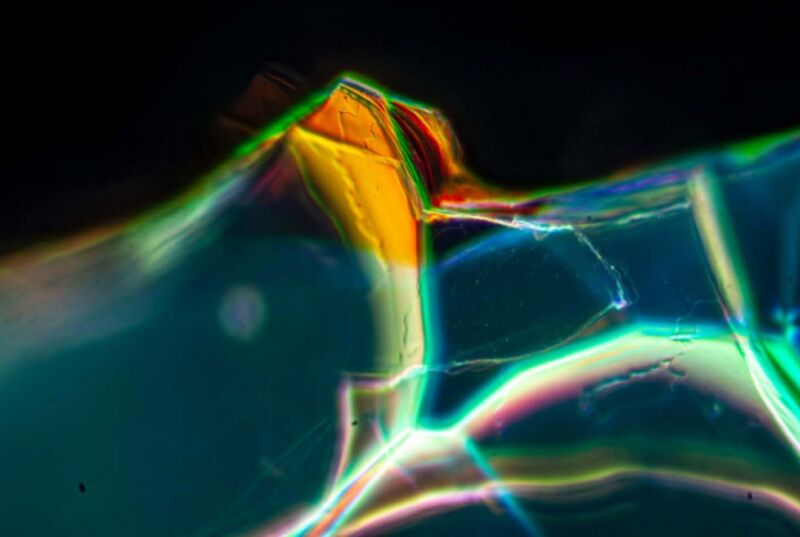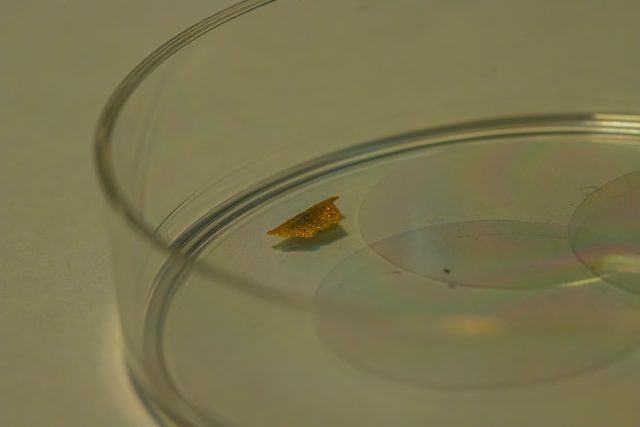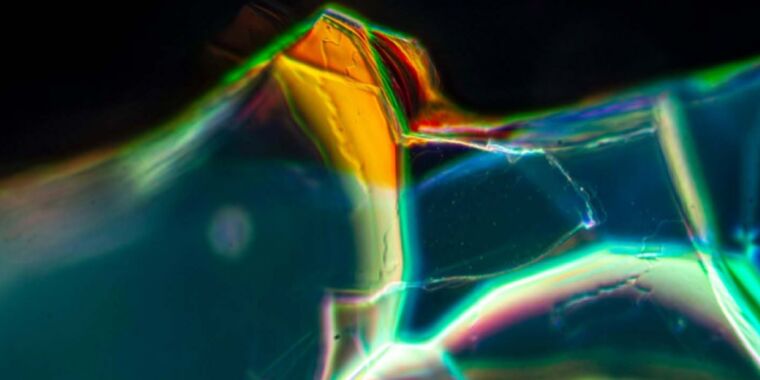
Giulia Guidetti
Nature is the ultimate nanofabricator. The latest evidence of that is an unusual shard of ancient Roman glass (dubbed the “wow glass”) that boasts a thin, golden-hued patina. Roman glass shards are noteworthy for their iridescent hues of blue, green, and orange—the result of the corrosion process slowly restructuring the glass to form photonic crystals—and this particular shard’s shimmering mirror-like gold sheen is a rare example with unusual optical properties, according to a new paper published in the Proceedings of the National Academy of Sciences.
It’s yet another example of naturally occurring structural coloration. As previously reported, the bright iridescent colors in butterfly wings, soap bubbles, opals, or beetle shells don’t come from any pigment molecules but from how they are structured—naturally occurring photonic crystals. In nature, scales of chitin (a polysaccharide common to insects), for example, are arranged like roof tiles. Essentially, they form a diffraction grating, except photonic crystals only produce specific colors, or wavelengths, of light, while a diffraction grating will produce the entire spectrum, much like a prism.
Also known as photonic band-gap materials, photonic crystals are “tunable,” which means they are precisely ordered to block certain wavelengths of light while letting others through. Alter the structure by changing the size of the tiles, and the crystals become sensitive to a different wavelength. They are used in optical communications as waveguides and switches, as well as in filters, lasers, mirrors, and various anti-reflection stealth devices.
Scientists can make their own structural colored materials in the lab, but it can be challenging to scale up the process for commercial applications without sacrificing optical precision. So creating structural colors like those found in nature is an active area of materials research. For example, earlier this year, scientists from the University of Cambridge developed an innovative new plant-based film that gets cooler when exposed to sunlight, making it ideal for cooling buildings or cars in the future without needing any external power source. The films created are colored, but it is structural color in the form of nanocrystals, not due to adding pigments or dyes.
And last year, Massachusetts Institute of Technology scientists adapted a 19th-century holographic photography technique invented by physicist Gabriel Lippmann to develop chameleon-like films that change color when stretched. The films would be ideal for making bandages that change color in response to pressure, letting medical professionals know if they are wrapping a wound too tightly—an important factor when treating conditions like venous ulcers, pressure ulcers, lymphoedema, and scarring. Children would love wearing bandages that change color, providing a boon for pediatricians. And being able to make large sheets of the material opens up applications in apparel and sportswear.

Fiorenzo Omenetto and Giulia Guidetti
Fiorenzo Omenetto, a materials scientist at Tufts University who co-authored the new paper, spotted the unique shard while visiting the Italian Institute of Technology’s Center for Cultural Heritage Technology and decided it warranted further scientific study. “This beautiful sparkling piece of glass on the shelf attracted our attention,” said Omenetto. “It was a fragment of Roman glass recovered near the ancient city of Aquileia, Italy.” The center’s director nicknamed it the “wow glass.”
Aquileia was founded by the Romans in 181 BCE, initially as a military outpost, but it soon flourished as a center for trade, including forged metal, Baltic amber, wine, and ancient glass. “The discovery of a wood barrel containing 11,000 glass fragments in the wreck of a Roman ship in the sea waters in front of Aquileia demonstrates the city’s leading position in the exchange and processing of recycled glass along commercial routes,” the authors wrote. By the second century CE, at its peak, the city had a population of 100,000. Its fortunes diminished after being sacked by Attila and his Huns in 452, and again by the Lombards in 590. Today the town only has around 3,500 residents, but it remains a significant archaeological site.

